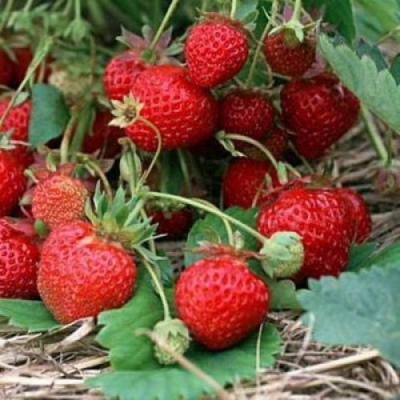
- Authors: A. A. Vysoukin, Kokinsky strong point
- Taste: sweet and sour, dessert
- Weight: 7-17 gr
- Yield: 70 - 90 kg per one hundred square meters
- Ripening terms: early
- Description of the bush: medium, semi-spreading, densely leafy
- Berry color: Dark red
- Winter hardiness: winter hardy
- Berry shape: regular round shape
- Pulp: dense
It's hard to find people who don't like strawberries at all. However, this is precisely why it is important to pay attention to its specific types. The Kokinskaya early strawberry variety definitely deserves a detailed analysis.
Breeding history of the variety
The plant was developed at the Kokinsky base of the Institute of Horticulture and Nursery (after which it got its name). The main selection work was carried out by A.A. Vysoukin. It is impossible to call the variety new - it entered the official test back in 1974. The hybrid is obtained thanks to the Ketskill and Maherauch strawberries. Since 1985, the crop has been included in the register of practical strawberry varieties.
Description of the variety
This plant:
has an average height;
partly spreading;
forms dense foliage;
gives shortened peduncles;
produces compact inflorescences;
early.
Ripening terms
Kokinskaya early refers, as the name suggests, to the early group of garden strawberries. There is no exact information. These will depend on the actual growing conditions at the time. Fruiting begins already in the first, rarely in the second year.
Yield
The same circumstances determine the difference in the fertility of a culture. It can be, under normal conditions, 70 kg (in terms of 1 hundred square meters). If the care is more careful, then the collection of berries is quite realistic to increase to 90 kg.
Berries and their taste
The fruits of Kokinskaya early strawberry are colored in a dark red tone. For them, the shape of the correct circle is typical, but the blush is not peculiar. The mass varies within a fairly wide range, from 7 to 17 g. The pulp is very dense, has a sweet and sour dessert taste. These properties make Kokinskaya early quite an attractive choice for planting in a private garden. However, the berries do not have decorative qualities, although they have an expressive aroma.
Growing features




Site selection and soil preparation
Since resistance to frost and drought is not characterized in the available sources, it is better to proceed from the most negative options. It is worth choosing the warmest and most comfortable place, not subject to cooling winds. And also it is necessary to pay attention that the site is neither excessively dry nor waterlogged. Initially slightly acidic earth is preferred. If this condition is not met, the soil must be corrected using standard agricultural techniques.
Sandy loam, loamy and simple clay soil perform equally well. According to some reports, black soil is also suitable for culture. Kokinskaya early is also a sun-loving plant, which must be taken into account when selecting a site. It needs moderate moisture during growth and fruiting. For 1 sq. m of the garden there should be a maximum of 4 plants. Irrigation is best organized using a drip pattern.
Fertilizers of the organic complex are applied immediately upon planting. The HKN complex will be needed during flowering. It is also used in the formation of ovaries. Weeds are removed in any case. But they are watching carefully so as not to deform the roots of the bush itself.

Pollination
The flowers of this variety are bisexual. He is guaranteed to pollinate himself. Therefore, if the thought that you will have to walk around the area with a brush is disturbing, you can safely discard it.

One of the important techniques in strawberry care is feeding. Regular fertilization guarantees a rich harvest. There are several different ways to feed strawberries, and each of them is designed for a specific period of plant development. During flowering, fruiting and after it, feeding should be different.
Frost resistance and the need for shelter
Kokinskaya strawberries will endure a normal winter in the middle lane calmly. It is designed for temperatures down to –25 and even –30 degrees Celsius. However, this only applies to rooted seedlings and mature plants. Young shoots must be covered, best of all with agrofibre. It is highly recommended to do this for all plants in severe or little snowy winters.

Diseases and pests
The plant is relatively resistant to powdery mildew. It also has an average susceptibility to verticillium and gray rot. To some extent, protection is provided by the rapid ripening of the berries. However, preventive treatments will definitely not be superfluous. The use of biological products that are safe for the environment is recommended.

Strawberries are often subject to many dangerous diseases that can seriously undermine their condition. Among the most common are powdery mildew, gray mold, brown spot, anthracnose, and verticillosis.Before buying a variety, you need to inquire about its disease resistance.
Reproduction
The topic of breeding strawberries of this particular variety in all available sources is bypassed with icy silence. Therefore, it can be assumed that universal recommendations are suitable:
if possible, use a mustache removed in July;
free all plants used for propagation from fruits so that they focus on their main task;
root the mustache in a coma of earth in a pot (this allows you to immediately achieve a strong, developed bush);
choose rosettes for planting, in which there are 4-5 thoroughly developed leaves.



















































































